Black Hickory
Carya texana
Juglandaceae (Walnut family)
Carya texana
Juglandaceae (Walnut family)
Description:
This tree is 30–60' tall (rarely taller), forming a trunk up to 2'
across and a variably shaped crown (oblongoid, ovoid, or globoid in
outline). Trunk bark of mature trees is dark gray or brownish gray,
coarsely rough-textured, and irregularly furrowed with interrupted
ridges; sometimes trunk bark is divided into plates and appears blocky.
The bark of branches is gray or brownish gray and less rough-textured,
while the twigs are mostly brown with white lenticels. Young twigs
earlier in the year are often sparsely covered with powdery yellow or
rust-colored scales, but they become glabrous later. The twigs
tend to be crooked and they are 3–4 mm. across at their tips. The
terminal buds are about 4–6 mm. long, ovoid in shape, and reddish brown
to yellowish brown; they are often covered with powdery yellow or
rust-colored scales earlier in the year, otherwise they become more
glabrous. Alternate compound leaves are produced along the twigs and
young shoots. These alternate leaves are odd-pinnate, usually with 7
leaflets (less often with 5 leaflets). The leaflets are 3–5½" long and
1½–2½" across; the lateral leaflets are smaller in size than the
terminal leaflet. The leaflets are lanceolate or elliptic-lanceolate in
shape and more or less
serrated along their margins. The lateral leaflets are sessile or
nearly so (petiolules are 0–1 mm. long), while the terminal leaflet is
short-stalked (petiolule is 4–10 mm. long). The upper leaflet surface
is yellowish green to dark green, hairless, and sometimes shiny, while
the lower leaflet
surface is dull light green and usually sparsely pubescent along the
central vein.
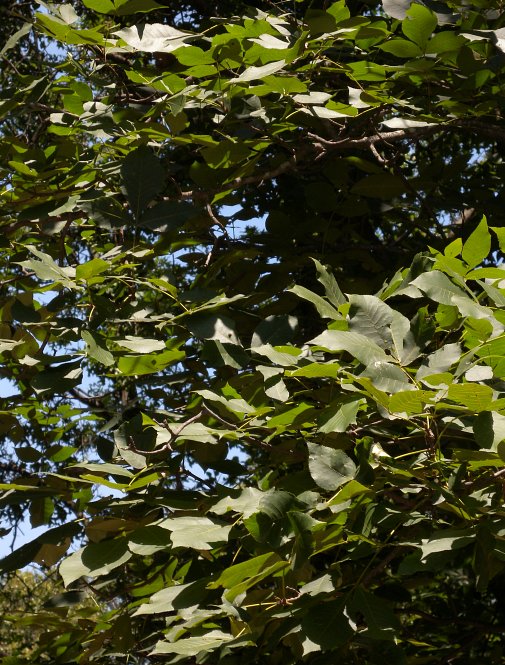
Earlier in the year, the lower leaflet surface often has yellow to reddish fine scales that fade away later in the summer. The petiole and central rachis of each compound leaf is light green or yellowish green and sparsely pubescent; earlier in the year, they also usually have powdery yellow to rust-colored scales that fade away with age. Black Hickory (Carya texana) is monoecious, producing female (pistillate) flowers and male (staminate) flowers at separate locations on the same tree. Either solitary or very short spikes of 2–3 female flowers are produced at the tips of branches early in the year. Individual female flowers are less than 1/8" (3 mm.) across, consisting of a 4-lobed green calyx that surrounds an ovary with reddish feathery stigmas. The male flowers are produced near the tips of branches in drooping yellowish catkins about 4–6" long. Individual male flowers are arranged in groups of 3 along the central stalk of each catkin; each male flower is less than 1/8" (3 mm.) across, consisting of a toothed calyx and several stamens. The blooming period occurs during mid- to late spring, lasting about 1–2 weeks; the flowers are cross-pollinated by the wind. Fertile female flowers are replaced by husked nuts that develop during the summer. During autumn, these husked nuts become mature and fall from the tree. Mature husked nuts are 1¼–1¾" long, ovoid-globoid in shape, and slightly compressed (flattened); the fleshy husk is about 2–4 mm. thick and light green to brown with 4 shallow longitudinal indentations. This husk eventually splits into 4 segments to release the nut. The nuts of this tree are light brown, ovoid-globoid in shape, slightly compressed, and slightly angular; they have hard shells and edible meat. The root system produces a deep taproot. This tree reproduces by reseeding itself.
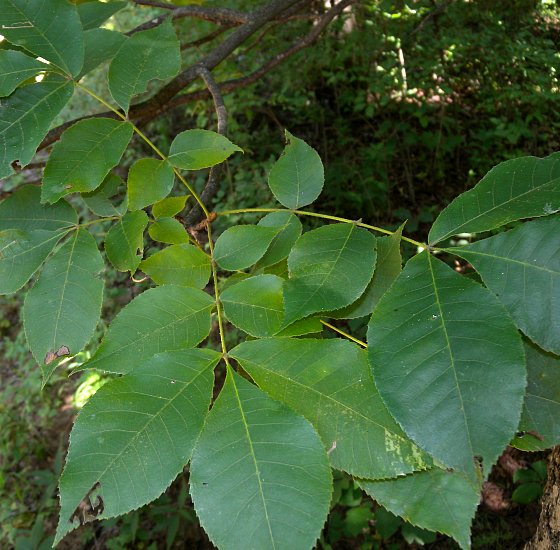
Cultivation: The preference is full to partial sun, mesic to dry conditions, and barren soil containing sand or rocky material. Because of its deep taproot, this tree is difficult to transplant. It is hardy to Zone 5. Hot dry conditions are tolerated.
Range & Habitat: Black Hickory (Carya texana) is occasional in southern Illinois, and rare elsewhere in the state (see Distribution Map), where it is native. This tree is found primarily in Missouri, Arkansas, and neighboring states; Illinois lies along the northern range limit of this tree. Habitats include upland rocky woodlands, upland sandy woodlands, upland rocky savannas, upland sandy savannas, rocky thinly-wooded bluffs, limestone glades, and areas along sandstone cliffs. Black Hickory is normally found in higher quality natural areas. It often occurs with Blackjack Oak (Quercus marilandica) or Post Oak (Quercus stellata).
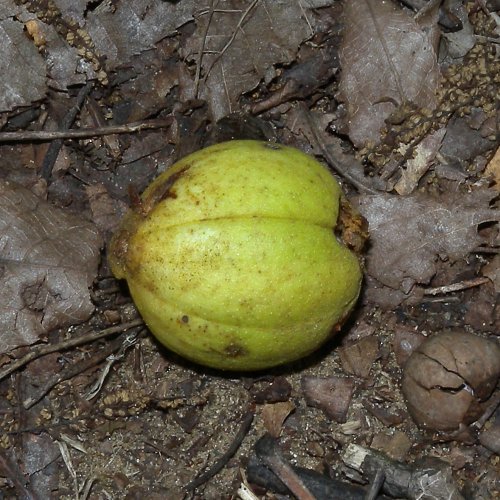
Faunal Associations: Many insects feed on various parts of hickories (Carya spp.). This includes such insects as the wood-boring larvae of Knulliana cincta cincta (Banded Hickory Borer), Megacyllene caryae (Painted Hickory Borer), and other long-horned beetles; the larvae of Conotrachelus aratus (Hickory Shoot Borer) and Conotrachelus hicoriae (Hickory Nut Curculio); larvae of Scolytus quadrispinosus (Hickory Bark Beetle); larvae of gall flies that form variably shaped galls on leaflets, such as Caryomyia caryaecola (Hickory Onion Gall Midge) and Caryomyia tubicola (Hickory Bullet Gall Midge); Lygocoris caryae (Hickory Plant Bug) and other plant bugs; Longistigma caryae (Giant Bark Aphid), Monellia microsetosa (Pignut Hickory Aphid), Monelliopsis nigropunctata (Yellow Hickory Aphid), and other aphids; various Eratoneura spp. (leafhoppers); Chionaspis caryae (Hickory Scurfy Scale) and other scale insects; various treehoppers; the foliage-feeding larvae of various sawflies; Diapheromera femorata (Northern Walkingstick); larvae of the butterflies, Satyrium calanus falacer (Banded Hairstreak) and Satyrium caryaevorum (Hickory Hairstreak); and larvae of such moths as Lophocampa caryae (Hickory Tussock Moth), Catocala insolabilis (Inconsolable Underwing), Actias luna (Luna Moth), Citheronia regalis (Regal Moth), Laothoe juglandis (Walnut Sphinx), and Cydia caryana (Hickory Shuckworm). The Insect Table provides a more complete list of these insect feeders.
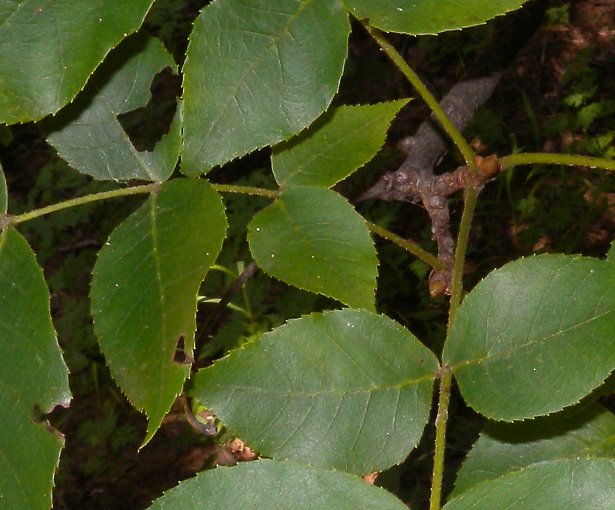
Hickory trees are also used by many vertebrate animals for various purposes. Many birds feed on the meat of either whole nuts or nuts that have been cracked open by other animals, such as squirrels. These birds include the Wood Duck, Northern Cardinal, American Crow, Blue Jay, Bobwhite Quail, Wild Turkey, Red-bellied Woodpecker, Tufted Titmouse, and White-breasted Nuthatch (see Bird Table). Mammals that feed on the nuts of these trees include the Eastern Gray Squirrel, Fox Squirrel, American Red Squirrel, Eastern Chipmunk, Raccoon, American Black Bear, and White-footed Mouse (Martin et al., 1951/1961; Whitaker, 1966; Beeman & Pelton, 1980). Hickory trees provide nest sites for various songbirds, including the Yellow-throated Vireo, Eastern Wood-pewee, Blue-gray Gnatcatcher, Cerulean Warbler, Scarlet Tanager, and Brown Creeper (Newell & Rodewald, 2011; DeGraaf, 2002). During the summer, the Eastern Red Bat and Northern Long-eared Bat use hickories as roost trees or sites for maternity colonies (Mager & Nelson, 2001; Krynak, 2010; Johnson et al., 2009).
Photographic Location: A sandy woodland at the Sand Prairie and Scrub Oak Nature Preserve in Mason County, Illinois.
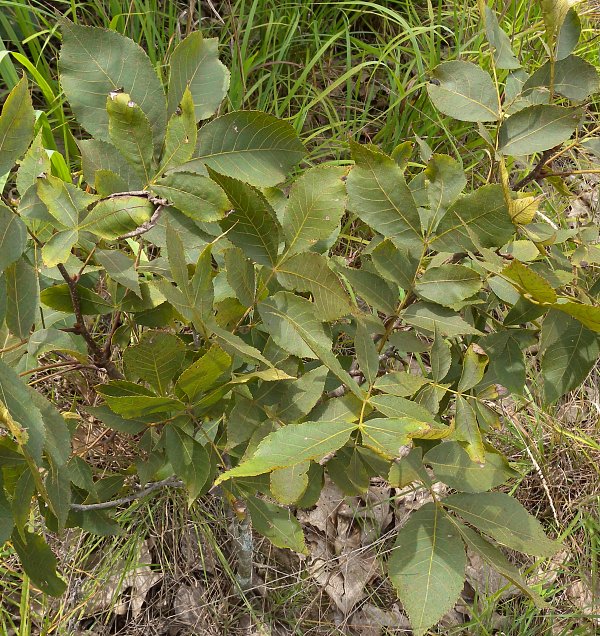
Comments: Black Hickory (Carya texana) is one of the less common hickory trees (Carya spp.) in Illinois. It is usually a relatively small to medium-sized tree, although sometimes it becomes large-sized. Like other hickories, this tree is rarely cultivated. Black Hickory belongs to the Pignut (Carya glabra) group of hickories. Hickories in this group have 5–7 leaflets per compound leaf, non-shaggy bark, small terminal buds, and nuts with thin husks. Black Hickory can be distinguished from other hickories in this group by the presence of yellowish or rust-colored scales on its young twigs, terminal buds, leaflet undersides, petioles, and rachises. Such scales are more visible earlier in the year; they may disappear entirely later in the year. In addition to these scales, there is usually sparse pubescence on the petioles and rachises of the compound leaves throughout the growing season. Pignut Hickory and Sweet Pignut Hickory (Carya ovalis), in contrast, lack such scales and their foliage is usually hairless. In addition, the terminal twig buds of Black Hickory are reddish brown or yellowish brown instead of brown, and its trunk bark tends to be more black and coarse, sometimes forming plate-like structures. Another species, the Mockernut Hickory (Carya tomentosa), has larger terminal buds, nuts with thicker husks, and its compound leaves have petioles and rachises that are more densely pubescent than those of Black Hickory.

Earlier in the year, the lower leaflet surface often has yellow to reddish fine scales that fade away later in the summer. The petiole and central rachis of each compound leaf is light green or yellowish green and sparsely pubescent; earlier in the year, they also usually have powdery yellow to rust-colored scales that fade away with age. Black Hickory (Carya texana) is monoecious, producing female (pistillate) flowers and male (staminate) flowers at separate locations on the same tree. Either solitary or very short spikes of 2–3 female flowers are produced at the tips of branches early in the year. Individual female flowers are less than 1/8" (3 mm.) across, consisting of a 4-lobed green calyx that surrounds an ovary with reddish feathery stigmas. The male flowers are produced near the tips of branches in drooping yellowish catkins about 4–6" long. Individual male flowers are arranged in groups of 3 along the central stalk of each catkin; each male flower is less than 1/8" (3 mm.) across, consisting of a toothed calyx and several stamens. The blooming period occurs during mid- to late spring, lasting about 1–2 weeks; the flowers are cross-pollinated by the wind. Fertile female flowers are replaced by husked nuts that develop during the summer. During autumn, these husked nuts become mature and fall from the tree. Mature husked nuts are 1¼–1¾" long, ovoid-globoid in shape, and slightly compressed (flattened); the fleshy husk is about 2–4 mm. thick and light green to brown with 4 shallow longitudinal indentations. This husk eventually splits into 4 segments to release the nut. The nuts of this tree are light brown, ovoid-globoid in shape, slightly compressed, and slightly angular; they have hard shells and edible meat. The root system produces a deep taproot. This tree reproduces by reseeding itself.

Cultivation: The preference is full to partial sun, mesic to dry conditions, and barren soil containing sand or rocky material. Because of its deep taproot, this tree is difficult to transplant. It is hardy to Zone 5. Hot dry conditions are tolerated.
Range & Habitat: Black Hickory (Carya texana) is occasional in southern Illinois, and rare elsewhere in the state (see Distribution Map), where it is native. This tree is found primarily in Missouri, Arkansas, and neighboring states; Illinois lies along the northern range limit of this tree. Habitats include upland rocky woodlands, upland sandy woodlands, upland rocky savannas, upland sandy savannas, rocky thinly-wooded bluffs, limestone glades, and areas along sandstone cliffs. Black Hickory is normally found in higher quality natural areas. It often occurs with Blackjack Oak (Quercus marilandica) or Post Oak (Quercus stellata).

Faunal Associations: Many insects feed on various parts of hickories (Carya spp.). This includes such insects as the wood-boring larvae of Knulliana cincta cincta (Banded Hickory Borer), Megacyllene caryae (Painted Hickory Borer), and other long-horned beetles; the larvae of Conotrachelus aratus (Hickory Shoot Borer) and Conotrachelus hicoriae (Hickory Nut Curculio); larvae of Scolytus quadrispinosus (Hickory Bark Beetle); larvae of gall flies that form variably shaped galls on leaflets, such as Caryomyia caryaecola (Hickory Onion Gall Midge) and Caryomyia tubicola (Hickory Bullet Gall Midge); Lygocoris caryae (Hickory Plant Bug) and other plant bugs; Longistigma caryae (Giant Bark Aphid), Monellia microsetosa (Pignut Hickory Aphid), Monelliopsis nigropunctata (Yellow Hickory Aphid), and other aphids; various Eratoneura spp. (leafhoppers); Chionaspis caryae (Hickory Scurfy Scale) and other scale insects; various treehoppers; the foliage-feeding larvae of various sawflies; Diapheromera femorata (Northern Walkingstick); larvae of the butterflies, Satyrium calanus falacer (Banded Hairstreak) and Satyrium caryaevorum (Hickory Hairstreak); and larvae of such moths as Lophocampa caryae (Hickory Tussock Moth), Catocala insolabilis (Inconsolable Underwing), Actias luna (Luna Moth), Citheronia regalis (Regal Moth), Laothoe juglandis (Walnut Sphinx), and Cydia caryana (Hickory Shuckworm). The Insect Table provides a more complete list of these insect feeders.

Hickory trees are also used by many vertebrate animals for various purposes. Many birds feed on the meat of either whole nuts or nuts that have been cracked open by other animals, such as squirrels. These birds include the Wood Duck, Northern Cardinal, American Crow, Blue Jay, Bobwhite Quail, Wild Turkey, Red-bellied Woodpecker, Tufted Titmouse, and White-breasted Nuthatch (see Bird Table). Mammals that feed on the nuts of these trees include the Eastern Gray Squirrel, Fox Squirrel, American Red Squirrel, Eastern Chipmunk, Raccoon, American Black Bear, and White-footed Mouse (Martin et al., 1951/1961; Whitaker, 1966; Beeman & Pelton, 1980). Hickory trees provide nest sites for various songbirds, including the Yellow-throated Vireo, Eastern Wood-pewee, Blue-gray Gnatcatcher, Cerulean Warbler, Scarlet Tanager, and Brown Creeper (Newell & Rodewald, 2011; DeGraaf, 2002). During the summer, the Eastern Red Bat and Northern Long-eared Bat use hickories as roost trees or sites for maternity colonies (Mager & Nelson, 2001; Krynak, 2010; Johnson et al., 2009).
Photographic Location: A sandy woodland at the Sand Prairie and Scrub Oak Nature Preserve in Mason County, Illinois.

Comments: Black Hickory (Carya texana) is one of the less common hickory trees (Carya spp.) in Illinois. It is usually a relatively small to medium-sized tree, although sometimes it becomes large-sized. Like other hickories, this tree is rarely cultivated. Black Hickory belongs to the Pignut (Carya glabra) group of hickories. Hickories in this group have 5–7 leaflets per compound leaf, non-shaggy bark, small terminal buds, and nuts with thin husks. Black Hickory can be distinguished from other hickories in this group by the presence of yellowish or rust-colored scales on its young twigs, terminal buds, leaflet undersides, petioles, and rachises. Such scales are more visible earlier in the year; they may disappear entirely later in the year. In addition to these scales, there is usually sparse pubescence on the petioles and rachises of the compound leaves throughout the growing season. Pignut Hickory and Sweet Pignut Hickory (Carya ovalis), in contrast, lack such scales and their foliage is usually hairless. In addition, the terminal twig buds of Black Hickory are reddish brown or yellowish brown instead of brown, and its trunk bark tends to be more black and coarse, sometimes forming plate-like structures. Another species, the Mockernut Hickory (Carya tomentosa), has larger terminal buds, nuts with thicker husks, and its compound leaves have petioles and rachises that are more densely pubescent than those of Black Hickory.